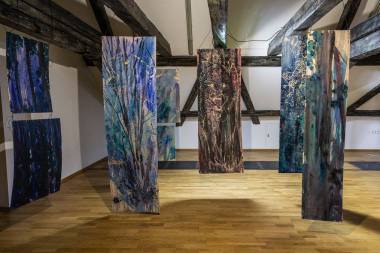Oľga Paštéková. Ako sa do hory volá?
Mirbachov palác, Galéria mesta Bratislavy, Františkánske námestie 11
26.4.-24.6.2018
Samostatná výstava Oľgy Paštékovej Ako sa do hory volá? predstavuje v novootvorenej Galérii mladých Galérie mesta Bratislavy príspevok k miestnešpecifickému uchopeniu daného priestoru. Podkrovie Mirbachovho paláca s výraznou trámovou stropnou konštrukciou zaplnila maliarka svojimi najnovšími prácami na preglejkách. Tie svojimi námetmi, rozmiestnením i materiálom symbolicky odkazujú k prostrediu lesa.
Oľga pokračuje v rozvíjaní svojej osobnej mytológie, ktorá je previazaná s námetmi divokých zvierat. Ako však názov výstavy naznačuje, kontextualizuje ju širšie rámcovanými otázkami ohľadne vzájomnej interakcie a spôsobu zaobchádzania ľudí s inými živočíšnymi druhmi. Z mestského prostredia predošlej série Animal versus City navracia svoje medvedice, havrany a vlky do ich prirodzeného prostredia. Ani tam sa však tiež nevyhnú stretnutiam s naším druhom – v reálnom či galerijnom priestore.
Vo viacerých filozofiách zdieľajú ľudia a zvieratá dôležitú spoločnú črtu, ktorá ich v istom zmysle zrovnoprávňuje – tzv. animu – dych, dušu. To sa premietlo aj do etymológie slova animal (v preklade zviera). Oľga sa s týmto zrovnoprávňujúcim pohľadom, aktualizovaným o súčasný diskurz odmietajúci antropocentrické hierarchizovanie živých bytostí, stotožňuje. Uvádza nás do symbolického a emočne silne nabitého priestoru, v ktorom sú zobrazené zvieratá aktívne, v pohybe, nárokujúc si na svoj životný priestor rovnakým dielom.
V Oľginej predošlej tvorbe, ktorá v podstate nikdy nevybočila z figuratívnej línie, sa častokrát objavuje motív tieňa. Jungiánska psychológia spája tiene s nevedomím alebo nejakými jeho aspektmi, či s kolektívnym nevedomím a strachmi. Jej havrany a vlky boli v podstate tiež vždy viac tieňmi ako reálnym zobrazením. Podľa potreby ich aktualizovala o naratívne nánosy z európskej kultúry – ako napríklad príbeh o Červenej Čiapočke. Interpretácie týchto príbehov sú podmienené nielen archetypálnym čítaním jednotlivých postáv a ich konania, ale aj dobovým kontextom. Dnes tento desivý príbeh v škatuľke rozprávky, ktorý bol v minulosti skôr moralizujúcim podobenstvom, asi najviac rezonuje v súvislosti s témou znásilnenia, ktorú otvorilo v globálnom meradle hnutie #metoo.
Pri aktuálnej výstave sa však Oľga pohráva so zobrazením animálnych stvorení mimo tradičných i aktualizovaných naratívov a to veľmi redukovaným gestickým rukopisom. Spoločne s dematerializáciou prevedenia samotných zvierat, ktoré vo výsledku pripomínajú sliny rozzúrených jedincov, prišlo aj k oživeniu použitej farebnej palety. Zobrazenia zvierat sa tu vo svojej ambivalentnej obrysovej (ne)prítomnosti stávajú stopami, indexmi živelnej sily, existenčného strachu a bezprostrednej slobody zároveň. Pohlcujú celú obrazovú plochu úzkych vysokých platní z priemyselne spracovaného prírodného materiálu.
Príroda a kultúra sa vo výstave zámerne prestupujú, poukazujúc na arbitrárnu opozíciu týchto dvoch kategórií. V rámci silnejúceho občianskeho a enviromentálneho aktivizmu by sa mali dostať do popredia otázky prehodnocujúce vzťahy v rámci nášho regionálneho ekosystému. Kto je vlastne les? Ako veľmi sme si ho už domestifikovali? A čo sa z neho vlastne naspäť ozýva?
_______________________________________________________________________________________
Oľga Paštéková. What Comes Around?
Mirbach´s Palace, City Gallery Bratislava, Františkánske námestie 11
26.4.-24.6.2018
The solo exhibition of Oľga Paštéková What comes around? introduces her site-specific reaction to the newly established Gallery of the Youth of City Gallery Bratislava. Mirbach Palace’s attic with bold beam supporting system is filled with the artist’s latest works on plywood. This artwork is a symbolic reference to the forest – inspired by the forest environment, as well as using natural materials.
Oľga continues to develop her own personal mythology, which is firmly linked to the motifs of wild animals. However, as the title of the exhibition suggests, she contextualizes her works within broader questions concerning mutual interaction of people with other species. She uses bears, ravens and wolves from the city environment of her previous work Animal versus City and returns them to their natural surroundings. These animals cannot avoid encountering our species – in the forest as well as in the gallery space.
People and animals share in many philosophies an important common trait, which makes them equal in a certain sense so-called anima, which means breath or spirit / soul. This is reflected in etymology of the animal word as well. Oľga believes that all creatures are equal and there should be no hierarchy of living beings. She introduces the visitor to a strongly, emotionally charged environment, in which animals represent an active element, always on the move, demanding their space to live.
Oľga’s older works, which are consistent in their figurative rendering, are typical of usage of the theme of shadow. Jungian psychology connects the shadows with unconsciousness or with its certain aspects or with collective unconsciousness and fears. According to her needs, Oľga updated these symbolical layers as narratives from European culture – for instance the story of Little Red Riding Hood. The interpretation of such stories are conditional not only on archetypal reading of its main actors and their deeds, but also on period context. Nowadays, this fairytale, which was in the past a moral tale, resonates within the framework of #metoo discourse as well.
In her current exhibition, Oľga experiments with the representation of these animal outside of their traditional narratives and she does so with a very reduced gestic brushstrokes. Alongside the dematerialization of the motifs of animals, which reminds slavers of furious specimens, Oľga has broadened her color palette. Due to their ambivalent (un)presence in contours, the representations of the animals became traces, indexes of vital force, existential fear and deliberate freedom at the same time. They absorb the whole surface of narrow vertical slabs from industrially processed, but still natural material.
In this exhibition, nature and culture are intentionally intertwined, pointing to the arbitrary opposition of these two categories. Within the framework of the growing civic and environmental activism should appear the questions about relationships with and within our regional ecosystem. What exactly is the forest? How far have we domesticated it? And what goes around?









